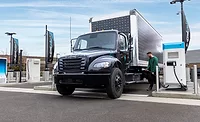Distribution
Discover the questions to ask when selecting a fleet fuel card
Fuel cards can help operations across any size

At some point, most beverage delivery operations have either incorporated fleet fuel cards into their businesses or at least explored the possibility.
Whether you’re in the market for a change of provider or completely new to fleet cards, here are some questions you should answer before you find the right one.
How much are my drivers going to save with that particular fuel card?
The most compelling argument for implementing the use of fuel cards is that your fleet will save money in the long run.
“Generally speaking, when you’re using a fuel card, if you’re using it appropriately and you use it enough at the right gas stations, you will save money over time,” says Tyler Linn, content and SEO specialist at fleet technology and solutions provider Forward Thinking, who’s researched and written extensively on the topic.
But not all discounts are the same, and you really have to weigh percentage of the cost savings against the accessibility of the fuel stations that accept a particular card. The closest thing to a universally accepted card — around 45,000 stations nationwide — is the WEX FlexCard. Wherever you’re located and whatever the driver’s route, it’s not likely they’ll have to travel off course to fill up at a WEX-compatible station. However, the savings is also likely to be the lowest, around 3 cents a gallon.
Then there’s something like the TCS card, which offers a 45 cents-per-gallon discount — a pretty substantial savings when used frequently. However, the fueling station options are likely to be significantly more limited, about 1,200 across the United States.
Meanwhile, the Pilot Flying Jay Axle Card does things a bit differently, offering 3% cashback on purchases. But it’s not likely to be the best option for local beverage delivery, as there are only about 950 stations nationwide that accept it.
How regionally oriented is the card?
You might select a card that’s accepted at, say, 2,000 or 3,000 stations in the United States, but the physical area in which they’re accepted could be greatly limited.
“Some of these cards are good for certain areas of the country and not for others,” Linn cautions. “I know that some of them are better for the eastern United States and they don’t really have a presence out west. So you’ve really got to pay attention to things like that as well.”
What are the bare-minimum (non-discount) benefits I should look for with any card?
For starters, you want to make sure the card offers International Fuel Tax Association (IFTA) support. “What you’re getting with that is your data with your fuel purchases,” says Linn. “You’ll be able to access that and incorporate it into your IFTA tax reports.”
Additionally, you’re going to want to make sure any data from the card can be integrated in whatever fuel management software system you’re currently using. “So, any fuel purchases are automatically logged into your fleet software,” Linn says.
Is my operation too small for a fleet fuel card?
“I think it can make sense for any fleet,” Linn notes. “At the end of the day, if you’re saving 15 cents per gallon, you’re saving 15 cents per gallon.”
Looking for a reprint of this article?
From high-res PDFs to custom plaques, order your copy today!




